The Fundamental Unit of Life Class 9 Notes Science Chapter 5
Introduction
Cells are the basic building blocks of all living organisms. They are the smallest units of life and can carry out all the necessary functions to sustain an organism. Just like how a house is made up of many rooms, a living organism is made up of many cells working together.
Discovery of Cells by Robert Hooke
- In 1665, a scientist named Robert Hooke was looking at a thin slice of cork through a microscope he had designed himself.
- He noticed that the cork looked like it was made up of many tiny compartments, similar to a honeycomb. Cork comes from the bark of a tree.
- Hooke decided to call these tiny compartments "cells" (Latin word "cellula," meaning a small room), and he observed dead cells in cork.
- This observation was very important because it was the first time anyone had seen that living things seem to be made up of separate units.
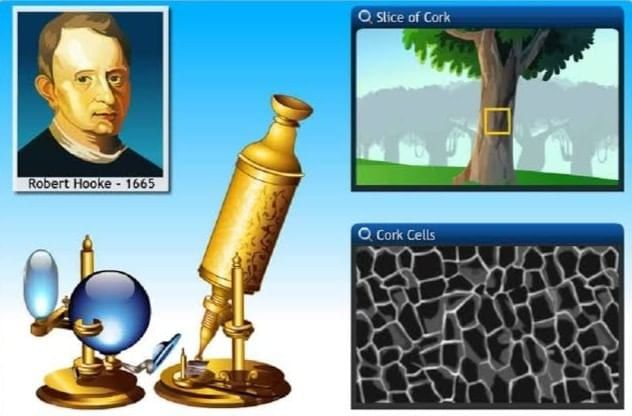
What are Living Organisms Made Up of?
To find out, let's Perform One Activity
Introduction:
- The epidermis of an onion bulb is a single layer of cells that can be easily peeled off.
- This thin layer of cells can be used to prepare a temporary mount for microscopic observation.
Materials Required: Onion bulb, Forceps, Watch glass, Water, Glass slide, Safranin solution, Cover slip, Mounting needle, Thin camel hair paintbrush (optional).
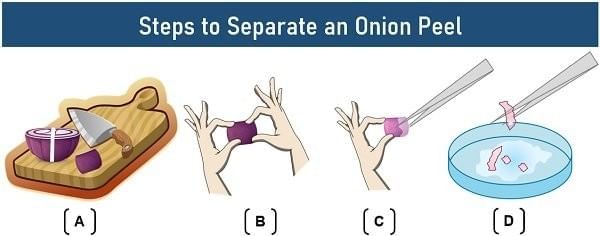
Procedure:
1. Peeling the Onion Skin: Using forceps, carefully peel off the epidermis from the concave side of the onion bulb.
2. Placing the Peel in Water: Immediately place the peeled layer in a watch glass containing water. This prevents the peel from folding or drying out.
3. Transferring the Peel to the Slide and then Preparing the Slide
(i) Take a glass slide and put a drop of water on it.
(ii) Transfer a small piece of the peel from the watch glass to the slide, ensuring it is flat. A thin camel hair paintbrush can help with this.
4. Adding Safranin and Staining the Peel
(i) Add a drop of safranin solution to the peel.
(ii) Carefully place a cover slip over the peel, using a mounting needle to avoid air bubbles.
5. Observing the Slide
(i) You have now prepared a temporary mount of onion peel.
(ii) Observe the slide under low power and then high power of a compound microscope to see the details of the onion cells.
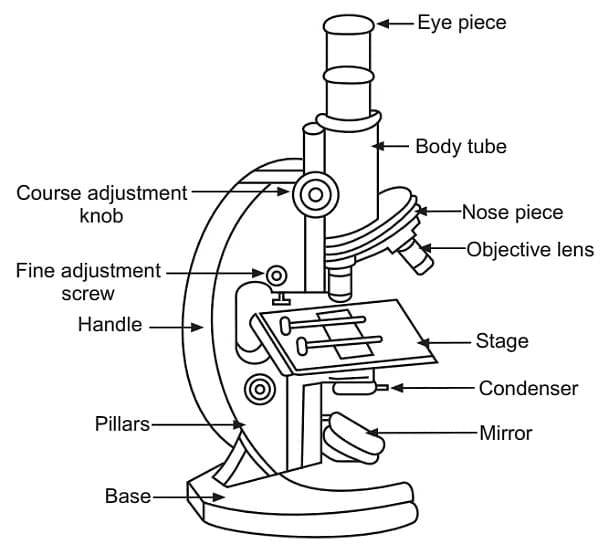
6. Observation
(i) These structures look similar to each other. Together they form a big structure like an onion bulb!
(ii) We find from this activity that onion bulbs of different sizes have similar small structures visible under a microscope.
(iii) The cells of the onion peel will all look the same, regardless of the size of the onion they came from.
(iv) These small structures that we see are the basic building units of the onion bulb.
(v) These structures are called cells.
(vi) Not only onions, but all organisms that we observe around us are made up of cells.
(vii) However, there are also single cells that live on their own.
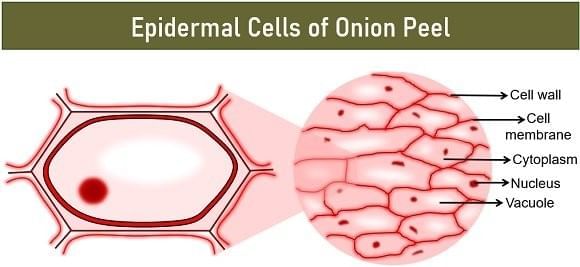
Scientists' Contributions in Cell Discovery and Theory
- Robert Hooke (1665). Discovered cells by observing a cork slice under a primitive microscope.
- Antonie van Leeuwenhoek (1674). Using an improved microscope, he was the first to observe free-living cells in pond water.
- Robert Brown (1831). Identified the nucleus within the cell.
- Jan Evangelista Purkinje (1839). Coined the term 'protoplasm' for the cell's fluid substance.
- Matthias Schleiden (1838) and Theodor Schwann (1839). Proposed the cell theory, stating that all plants and animals are made of cells and that the cell is the basic unit of life.
- Rudolf Virchow (1855). Expanded the cell theory by asserting that all cells arise from pre-existing cells.
- Electron Microscope (1940). Enabled the observation and understanding of the complex structure of cells and their various organelles.
Types of Organisms
Based on the number of cells, organisms are classified into two categories:
(a) Unicellular Organisms: These are single-celled organisms that carry out all life functions independently. Examples include Amoeba, Paramecium, Chlamydomonas, and various types of bacteria.

(b) Multicellular Organisms: These organisms are made up of many cells that work together, each taking on different roles to form various body parts. Examples include fungi, plants, and animals.
- The shape and size of cells relate to their specific functions. There is a division of tasks among cells. Interestingly, mfost eukaryotic cells contain similar organelles, no matter their function or the type of organism they belong to.
Interesting facts and Functions of Cells in Human Body
Nerve Cell: Longest cell in the human body; carries messages across the body.
Blood Cells: Red blood cells have no nucleus; transport oxygen and fight infections.
Smooth Muscle Cell: Involuntary in action; helps organs like intestines to contract and relax.
Bone Cell: Stores calcium; helps build and maintain strong bones.
Fat Cell: Stores energy as fat; provides insulation and cushioning.
Ovum (Egg Cell): Largest human cell; carries mother’s DNA and supports early development.
Sperm: Smallest human cell with a tail; fertilizes the ovum to begin reproduction.
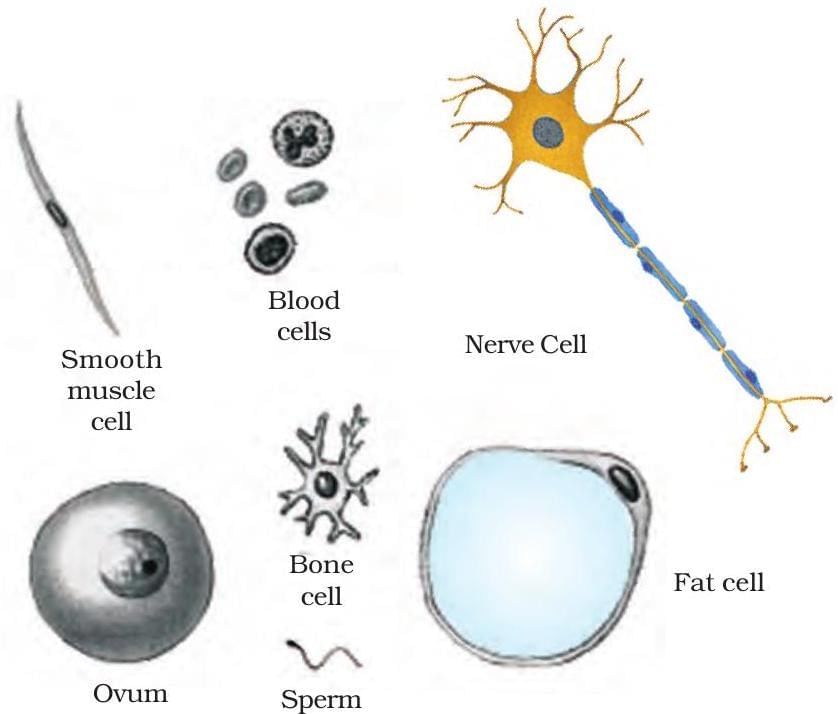 Various cells from the human body
Various cells from the human body
We already know that all living organisms are made up of cells. But have you ever wondered what’s inside a cell that allows it to do so many important jobs? Let’s find out and explore the tiny parts inside a cell that help it stay alive and work properly.
What is a Cell Made Up of? What is the Structural Organisation of a Cell?
(a) Plasma Membrane or Cell Membrane
The plasma membrane is the outer layer of the cell that separates its contents from the outside environment. It allows certain materials to enter and exit the cell while blocking others, making it a selectively permeable membrane.
How does the movement of substances take place into the cell?
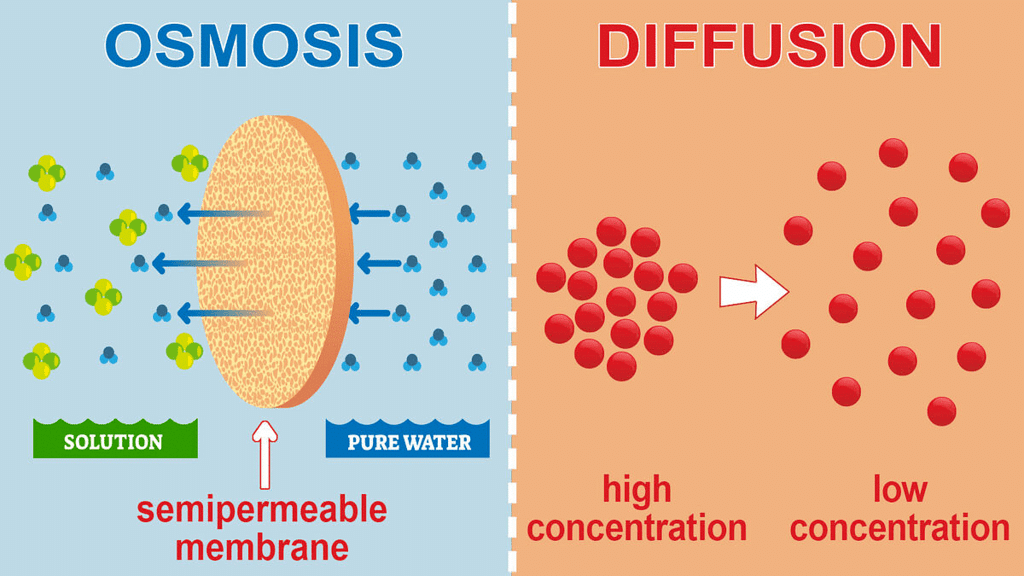
Types of Movement
- Diffusion (For movement of gas): This is the natural movement of a substance from an area of high concentration to an area of low concentration. Gases like carbon dioxide or oxygen can pass through the cell membrane by diffusion. Other molecules require energy for transport in and out of the cell.
- Osmosis (For Movement of Water): Osmosis is the diffusion of water across a selectively permeable membrane from an area of lower solute concentration to an area of higher solute concentration. Key Point: Osmosis is a special case of Diffusion
What happens if we place an animal or plant cell in a sugar or salt solution? One of three outcomes may occur:
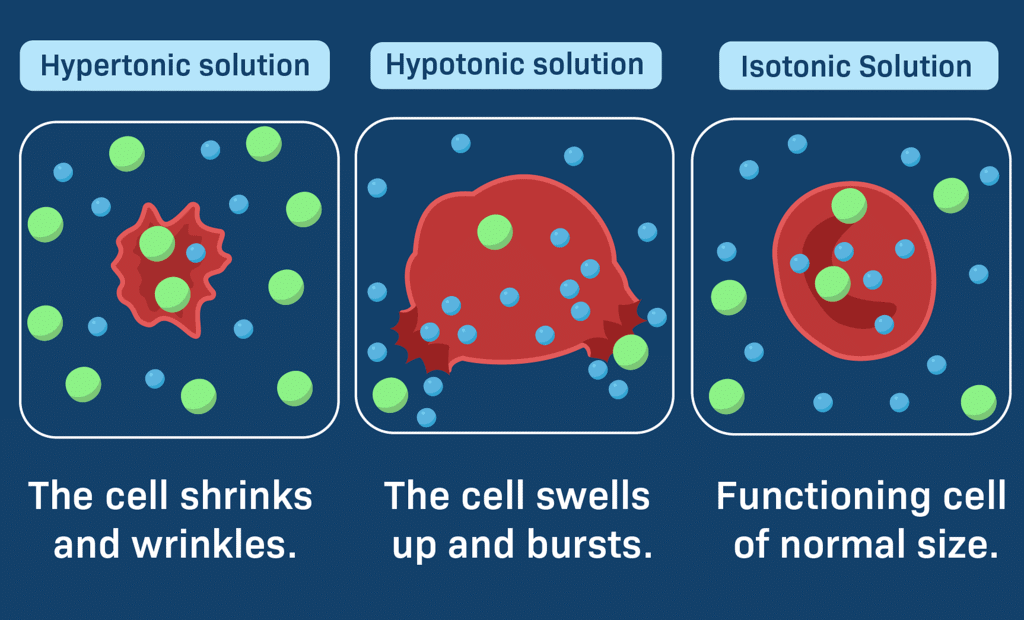
- Hypotonic Solution: If the surrounding solution has a higher concentration of water than the cell, the cell will absorb water through osmosis. This is known as a hypotonic solution, leading to more water entering the cell than leaving it.
- Isotonic Solution: If the surrounding solution has the same concentration of water as the cell, there will be no net movement of water across the cell membrane. This is an isotonic solution, where water moves in and out at equal rates.
- Hypertonic Solution: If the surrounding solution has a lower concentration of water than the cell, the cell will lose water through osmosis. This is a hypertonic solution, causing the cell to shrink as water exits.
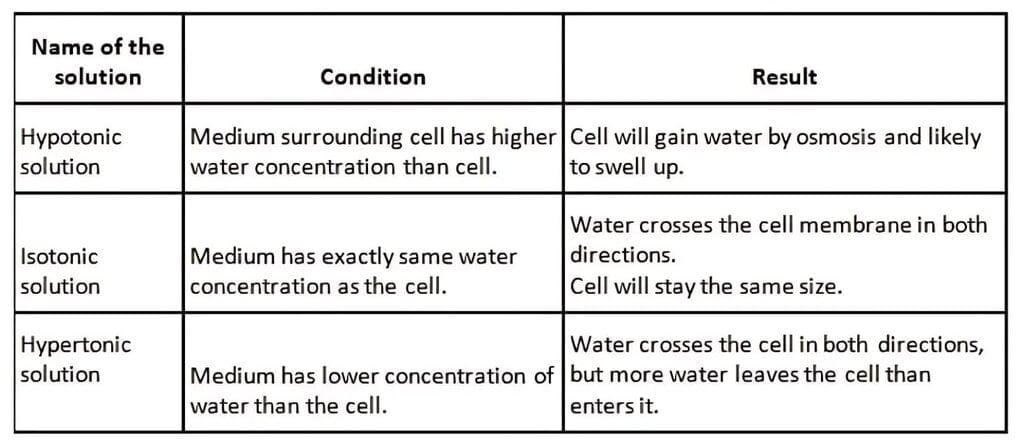
Examples and facts of Diffusion and Osmosis
1. A de-shelled egg placed in pure water swells because water enters the egg by osmosis. The same egg placed in concentrated salt solution shrinks as water moves out of the egg.
2. Dried raisins or apricots swell in plain water as they gain water by osmosis. In concentrated sugar/salt solution, they shrink due to loss of water.
3. Osmosis is important in plant roots and unicellular freshwater organisms for absorbing water.
4. Diffusion is important for exchange of gases and water in and out of the cell.
5. The plasma membrane, made of lipids and proteins, controls the movement of substances in and out of the cell, and its flexibility allows the cell to engulf food by endocytosis, as seen in Amoeba.
(b) Cell Wall
In addition to the plasma membrane, plant cells have a tough outer layer called the cell wall. This wall is located outside the plasma membrane and is mainly made of cellulose, a complex substance that gives plants their structural strength.
When a living plant cell loses water through osmosis there is shrinkage or contraction of the contents of the cell away from the cell wall. This phenomenon is known as plasmolysis.

Function of Cell Wall
- Cell walls allow plant, fungal, and bacterial cells to endure very dilute (hypotonic) external solutions without bursting. In such solutions, cells absorb water through osmosis, causing them to swell and exert pressure against the cell wall. The wall then pushes back, creating equal pressure.
- Due to their walls, plant cells can handle much larger changes in their environment compared to animal cells.
(c) Nucleus
- The nucleus has a double layer called the nuclear membrane.
- The nuclear membrane has pores that allow materials to move between the nucleus and the cytoplasm.
- The nucleus contains chromosomes, which are visible as rod-shaped structures only when the cell is about to divide.
- Chromosomes hold the information needed to pass traits from parents to their children in the form of DNA (Deoxyribonucleic Acid).
- Chromosomes are made up of DNA and protein.
- DNA molecules carry the information required for building and organising cells.
- Functional parts of DNA are known as genes.
- In a non-dividing cell, DNA exists as chromatin material, which looks like a tangled mass of thread-like structures.
- When the cell is ready to divide, the chromatin organises into chromosomes.
- The nucleus is vital for cell reproduction, which is when a single cell divides to form two new cells.
- The nucleus also plays an important role, along with the environment, in guiding how the cell develops and what it looks like when it matures.
- It directs the chemical activities of the cell.
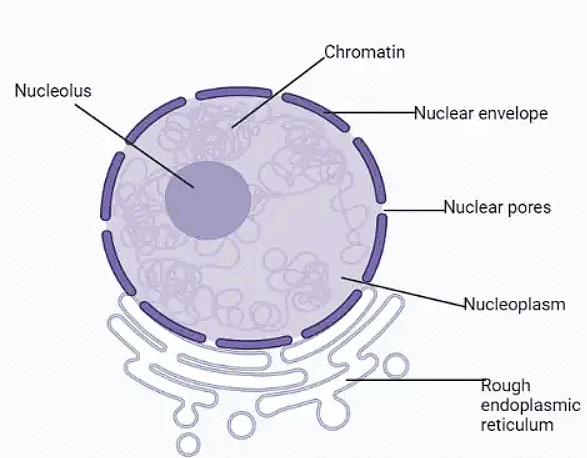 Nucleus of a Eukaryotic cell
Nucleus of a Eukaryotic cell
Prokaryotic and Eukaryotic Cells
Prokaryotic Cells
- Prokaryotes are organisms with cells that do not have a nuclear membrane.
- Typically, prokaryotic cells are small, ranging from 1 to 10 µm in size.
- They contain a nucleoid, which is an area with nucleic acids but lacks a surrounding membrane.
- Prokaryotic cells do not have membrane-bound organelles.
- They possess a single chromosome made of nucleic acid.

Eukaryotic Cells
- Eukaryotes are organisms with cells that have a nuclear membrane.
- Eukaryotic cells are generally larger, measuring from 5 to 100 µm.
- They have a defined nuclear membrane and contain multiple chromosomes.
- Eukaryotic cells include complex organelles that perform specific functions.
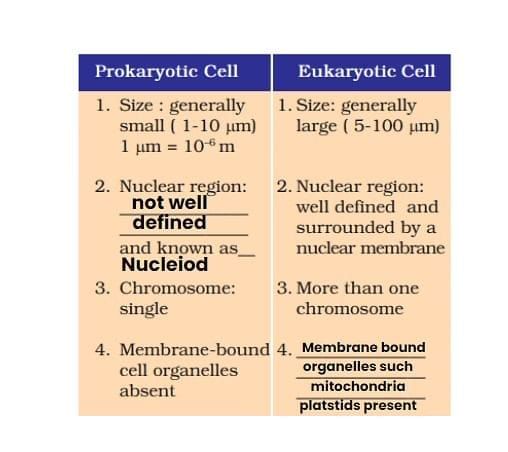
Cytoplasm
- The cytoplasm is the fluid inside the plasma membrane.
- It contains various specialised cell organelles, each with specific roles.
- The cytoplasm facilitates the exchange of materials between organelles.
- It also stores essential chemicals like amino acids, glucose, vitamins, and iron.
- The cytoplasm is where certain metabolic pathways, such as glycolysis, take place.
Cell Organelles
Organelles are specialised structures that perform different tasks within cells. The term literally means “little organs.” Just as organs like the heart, liver, stomach, and kidneys have specific functions to keep an organism alive, organelles have specific roles to support the life of a cell.
1. Endoplasmic Reticulum (ER)
The endoplasmic reticulum (ER) is a large network of membrane-bound tubes and sheets that resemble long tubules or round bags called vesicles. The structure of the ER membrane is similar to that of the plasma membrane, made up of lipids and proteins. There are two types of ER: rough endoplasmic reticulum (RER) and smooth endoplasmic reticulum (SER).
Although the ER can look different in various cells, it consistently forms a network system.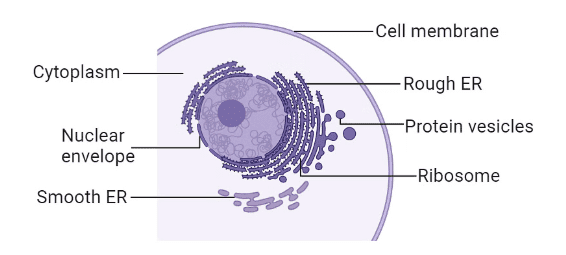 Endoplasmic Reticulum
Endoplasmic Reticulum
Types of Endoplasmic Reticulum
Functions of Rough and Smooth Endoplasmic Reticulum
- The RER contains ribosomes, which are the sites for protein production. These proteins are transported to different parts of the cell as needed.
- The SER aids in creating lipids, which are essential for cell function.
- Some proteins and lipids serve as enzymes and hormones.
- The ER acts as channels, transporting materials (especially proteins) within the cytoplasm or between the cytoplasm and the nucleus.
- The endoplasmic reticulum provides a cellular framework in the cytoplasm, supporting specific cell activities.
- In vertebrate liver cells, the SER is vital for detoxifying various poisons and drugs.
2. Golgi Apparatus
The Golgi apparatus is made up of a system of membrane-bound vesicles that are arranged in stacks known as cisterns. These membranes often connect with the membranes of the ER, forming part of a complex cellular membrane system.  Golgi Apparatus
Golgi Apparatus
Function of the Golgi Body
- The material synthesised near the ER is packaged and dispatched to various targets inside and outside the cell through the Golgi apparatus.
- Its functions include the storage, modification and packaging of products in vesicles. In some cases, complex sugars may be made from simple sugars in the Golgi apparatus.
- The Golgi apparatus is also involved in the formation of lysosomes.
3. Lysosomes
Lysosomes act as the waste disposal system of the cell. They have a membrane-bound structure and contain digestive enzymes made by the rough endoplasmic reticulum (RER).
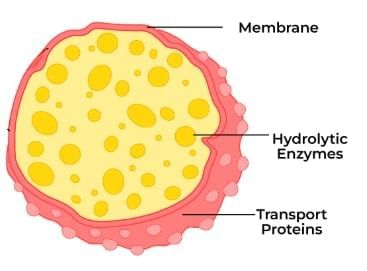 Lysosome
Lysosome
Functions of Lysosomes
- Lysosomes break down foreign materials entering the cell, like bacteria or food, and also old organelles into smaller pieces.
- They contain powerful digestive enzymes that turn complex substances into simpler ones.
- They break down old organelles.
- If the cell is damaged, lysosomes may burst and the enzymes can digest their own cell. Hence, lysosomes are sometimes called the 'suicide bags' of a cell.
4. Mitochondria
Mitochondria are known as the powerhouse of the cell.
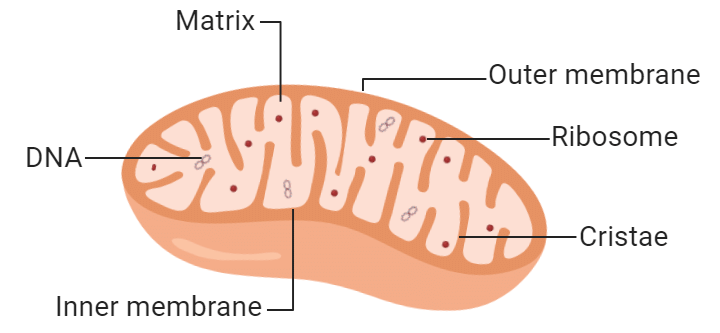 Mitochondria
Mitochondria
Structure of Mitochondria
- Mitochondria have two membrane coverings.
- The outer membrane is very porous, while the inner membrane has deep folds. These folds create a large surface area for ATP-generating chemical reactions.
Functions of Mitochondria
- Mitochondria release energy needed for various chemical processes required for life in the form of ATP (Adenosine triphosphate) molecules. ATP is recognised as the energy currency of the cell.
- The body uses energy stored in ATP to create new chemical compounds and for mechanical work.
- Mitochondria are unique as they have their own DNA and ribosomes, allowing them to produce some of their own proteins.
5. Plastids
Plastids are found only in plant cells.
There are two types of plastids:
- Chromoplasts (coloured plastids).
- Leucoplasts (colourless plastids) mainly store materials like starch, oils, and protein granules.
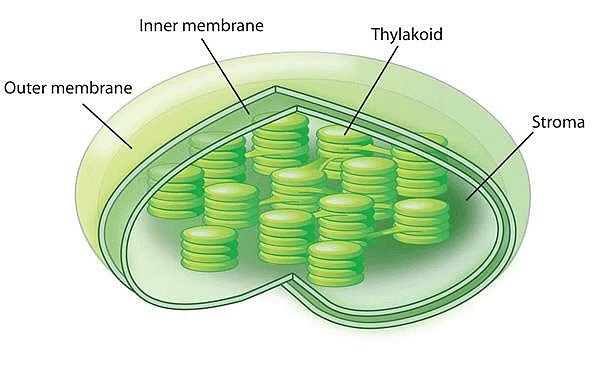 Plastid
Plastid
Structure of Plastids
- The plastids' internal structure includes multiple layers of membranes surrounded by a substance known as the stroma.
- Plastids also have their own DNA and ribosomes, like mitochondria, and are similar to mitochondria in their structure
Function of Plastids
- Chloroplasts are important for photosynthesis in plants.
- Leucoplasts are primarily organelles in which materials such as starch, oils and protein granules are stored.
6. Vacuoles
Vacuoles are storage sacs that hold solid or liquid materials. In animal cells, they are typically small, while in plant cells, they can be quite large. The central vacuole in some plant cells may take up 50-90% of the cell's volume.

- In plant cells, vacuoles are filled with cell sap, which helps the cell maintain its shape and firmness. Vacuoles store many important substances for the plant cell, such as: Amino acids, Sugars, Various organic acids and Some proteins.
- In single-celled organisms like Amoeba, the food vacuole holds the food that the Amoeba has eaten. Some unicellular organisms have special vacuoles that are important for: (i) removing excess water from the cell and (ii) getting rid of certain wastes.
Cell Division
The process of creating new cells is known as cell division. New cells are produced in living organisms to:
- grow
- replace old, dead, and damaged cells
- form gametes needed for reproduction
There are two main types of cell division: mitosis and meiosis.
Mitosis or Mitotic Cell Division
Mitosis is the process through which most cells divide for growth. In this process, each original cell, known as the mother cell, splits to create two genetically identical daughter cells (Fig. 5.7). The daughter cells have the same number of chromosomes as the mother cell. This process is essential for the growth and repair of tissues in organisms.
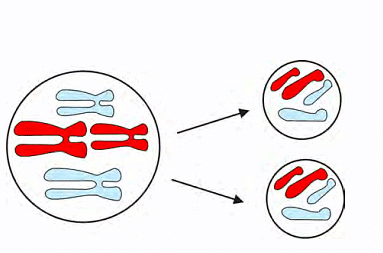 MITOSIS
MITOSIS
Meiosis or Meiotic Cell Division
In animals and plants, certain cells in reproductive organs or tissues divide to create gametes, which will develop into offspring after fertilisation. This division occurs through a different method called meiosis, which involves two successive divisions. When a cell undergoes meiosis, it produces four new cells instead of just two (Fig. 5.8). These new cells contain only half the number of chromosomes compared to the mother cells.
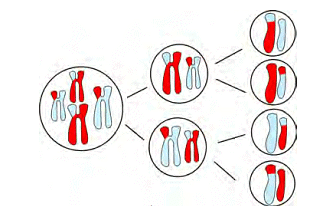 MEIOSIS
MEIOSIS
Difference between an Animal Cell and a Plant Cell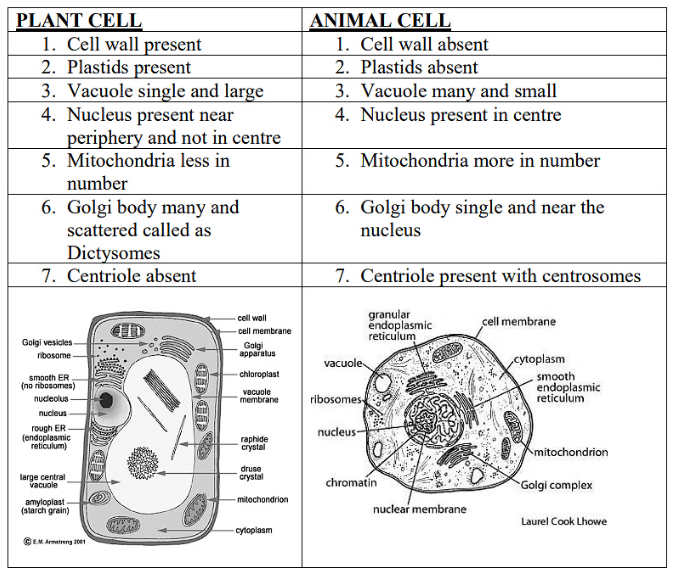
|
84 videos|541 docs|60 tests
|
FAQs on The Fundamental Unit of Life Class 9 Notes Science Chapter 5
| 1. What is cell theory and what are its main components? |  |
| 2. What are the main organelles found in a cell and their functions? |  |
| 3. How does cell division occur and what are the types of cell division? |  |
| 4. What is the structural organization of a cell? |  |
| 5. Why are cells considered the fundamental unit of life? |  |

















